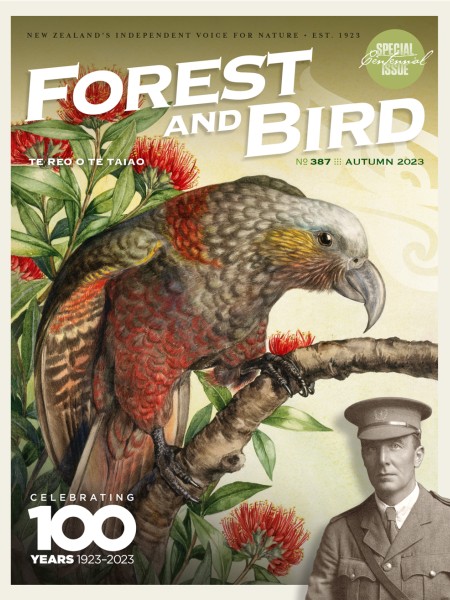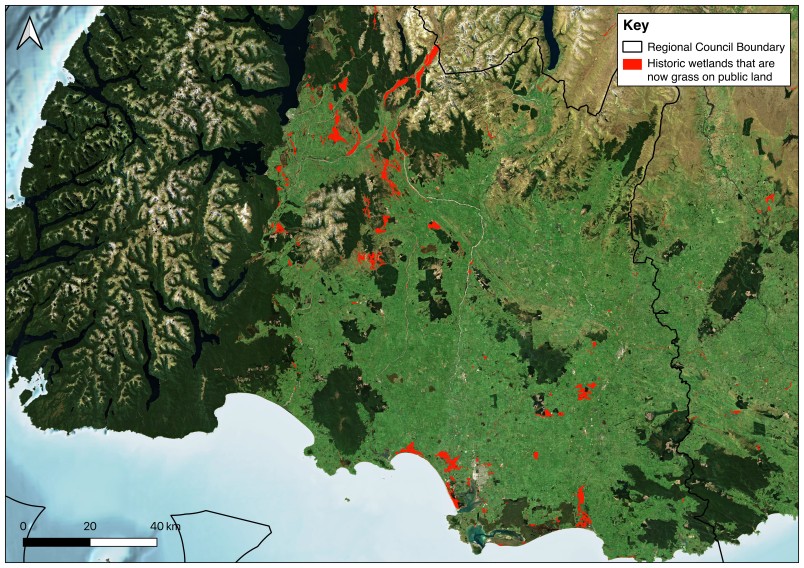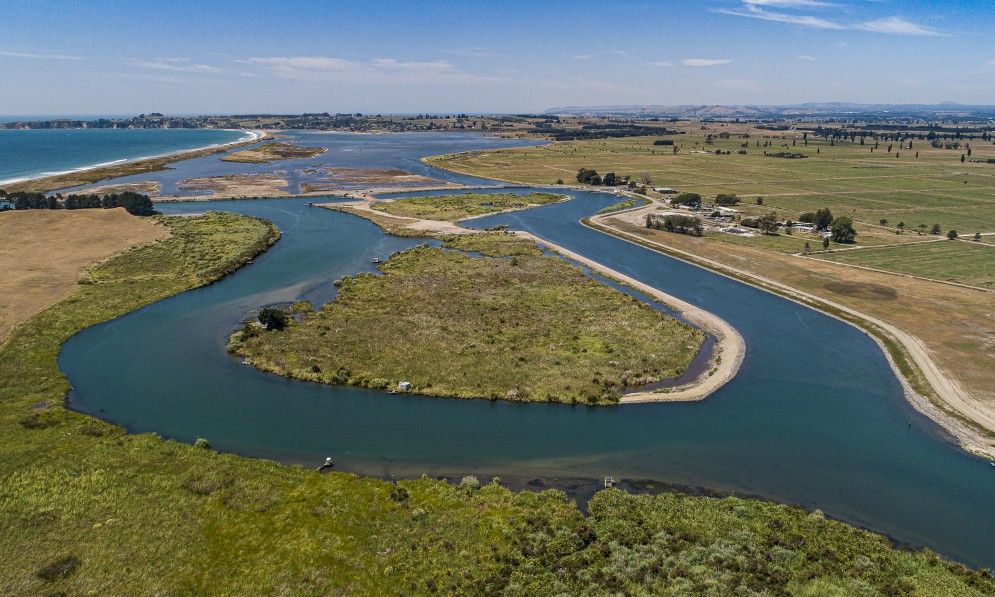A new report commissioned by Forest & Bird has revealed thousands of drained wetlands could be brought back to life. By Cate Hennessy and Caroline Wood
Forest & Bird magazine
A version of this story was first published in the Autumn 2023 issue of Forest & Bird magazine.

Sadly 90% of Aoteroa New Zealand's wetlands have been lost over the past 100 years after being drained and built on or turned into farm pasture, parks, mines, or quarries.
But the wonderful thing about wetlands is they have the potential to be rewetted, providing valuable new habitat for native species and helping mitigate climate change impacts.
You may have seen examples of this in this magazine recently with community-led wetland restoration projects in Coromandel and Southland.
Last year, Forest & Bird decided to find out how much former wetland was still in public ownership and therefore could be more easily restored by agencies.
We asked GIS mapping analyst Paul Hughes to identify historic wetlands across the country that could be brought back to life. We launched the findings in February on World Wetlands Day.
Forest & Bird’s freshwater advocate Tom Kay says about 125,000ha of river and stream margins, farmland, conservation land, parks, and other areas in public ownership could be considered for wetland restoration.
“These spaces have been cleared or drained and are now grassed, but there is a golden opportunity for councils and the government to restore many back to wetland ecosystems,” said Tom.
“Using Geographical Information System (GIS) software, we overlaid maps showing historic wetlands with other maps from the Central Record of State Land, the Land Cover Database, as well as maps from other sources.
“What we’ve discovered is a significant area of public land – in slivers, pockets, and larger areas – that were historically wetlands and could be again.”
The largest land holdings are managed by Pāmu Farms (29,000ha), the Department of Conservation (21,000ha), Land Information New Zealand (20,000ha), Southland Regional Council (3800ha), and the University of Canterbury (3400ha).

Historic wetlands in Southland (marked in red) that may have the potential to be restored. Image Forest & Bird
Forest & Bird hopes these organisations and local councils can build on our analysis and identify potential areas for wetland restoration. A couple have already contacted us to ask for our report and maps.
Several wetland restoration projects are already under way on public land, including:
- Kopurererua Valley wetland restoration and stream realignment (Tauranga City Council)
- Te Pourepo o Kaituna wetland creation (Bay of Plenty Regional Council, Department of Conservation, Tapuika, and Ngāti Whakaue)
- Queen Elizabeth Park wetland restoration as a permanent carbon sink (Greater Wellington Regional Council)
- Te Kuru wetland restoration and stormwater basin (Christchurch City Council)
- Fred Burn wetland protection and restoration, Southland, (Pāmu).
“The wetland restoration projects already happening around Aotearoa show what is possible,” added Tom.
“More and more councils and community groups are recognising the value of wetlands for carbon storage, climate resilience, biodiversity, and recreation.
“While some of the places identified in our report might not be suited to restoration, others would be ideal.”
Restoring wetlands will help the government achieve its climate, emissions, and biodiversity targets.
Forest & Bird hopes Ministers and council officials will use the findings contained in our new report Every Wetland Counts: Mapping the restoration potential of historic wetlands in public ownership as a starting point in identifying local sites for restoration.
Southland region has the most historic wetland still in public ownership (28,000ha), followed by the West Coast (20,000ha), Canterbury (18,000ha), Northland (16,000ha), Manawatū-Whanganui (11,000ha), and Waikato (10,000ha).
“Adding local data plus insights from iwi and community groups, it should be possible to prioritise potential projects all over the country,” said Tom. “We hope these findings will help communities start having these conversations.”
Lake Mahināpua wetlands near Hokitika. Image Caroline Wood
What is Forest & Bird doing?
Forest & Bird is campaigning for stronger wetland protections in Aotearoa while also working to restore wetlands in our own reserves.
Last year, Forest & Bird launched a new campaign called Every Wetland Counts | He Puipuiaki Ia Rohe Kōreporepo.
The campaign has six asks, including doubling natural wetland extent by 2050 and developing a national wetland restoration plan.
Our freshwater team is due to give an oral submission on our wetland asks to the government’s Environment Committee later this year.
As well as national advocacy, Forest & Bird’s branch volunteers look after wetlands in a string of reserves from Northland to Southland.
These include a rare dune lake ecosystem at Forest & Bird’s Arethusa Lodge, in Northland, the Fensham Reserve, in the Wairarapa, home to many rare plant species, and the Fleming wetland, in our Lenz Reserve, the Catlins, where spotless crake were recently discovered.
For decades, our volunteers have also helped restore wetlands on conservation and privately owned land in their communities.
This includes the Waitangi Regional Park wetland restoration (Napier Branch), the Waiū wetland restoration, Wainuiomata (Lower Hutt Branch), and Poukawa Stream (Hastings-Havelock North Branch).
For more information about wetland restoration, see www.worldwetlandsday.org.
Poukawa Stream restoration. Image supplied
SHOW SOME AROHA FOR WETLANDS
Watching our country’s biggest-ever climate events unfold earlier this year in Auckland, Northland, Tairāwhiti, and Hawke’s Bay was heart-breaking.
Many of us felt helpless watching water pouring into homes and businesses, and landslips and storm surges destroying homes and roads. The two cyclone-related storms of January and February brought fear into the hearts of many.
But we are not helpless. We can take action. There’s so much good we can do by working together to protect and restore New Zealand’s life-giving wetlands,including in urban areas.
They can be our shield in helping protect against further flooding and other worst-case-scenario climate events.
“Communities experience massive benefits when local wetlands are restored,” says Tom Kay, Forest & Bird’s freshwater advocate.
“There’s enormous potential for central and local government to identify and prioritise new wetland restoration projects, and we hope our report and maps will help them do this.”
Seven benefits of restoring wetlands
- Revive biodiversity
- Filter and replenish water supply
- Store carbon
- Blunt the impact of floods and storms
- Improve livelihoods
- Boost eco-tourism
- Enhance wellbeing
Please take a stand and show your love for our wetlands by making a donation today. Together, we can help our precious natural wetlands keep nature and communities safe.
Donate today at www.forestandbird.org.nz/save-our-wetlands.

